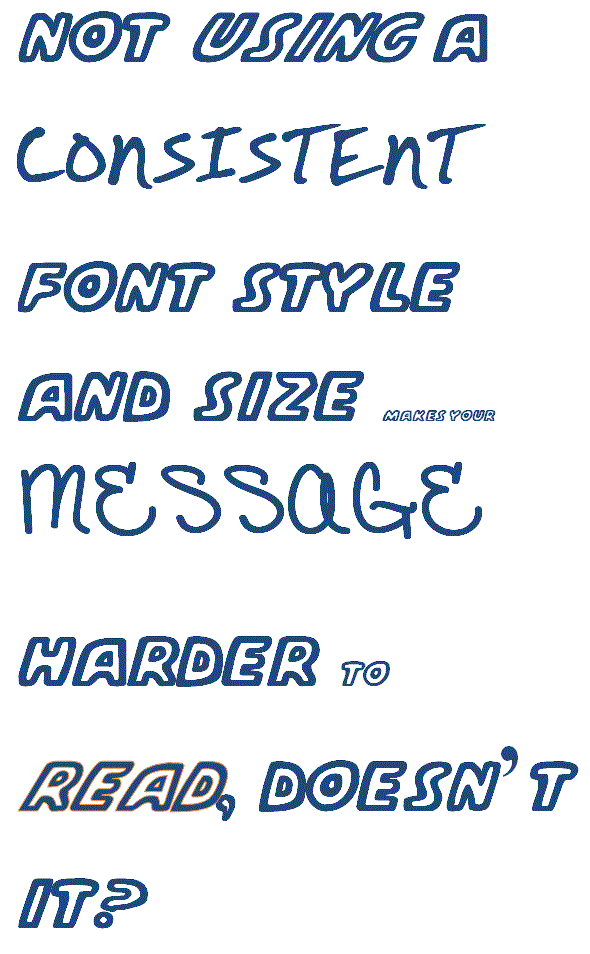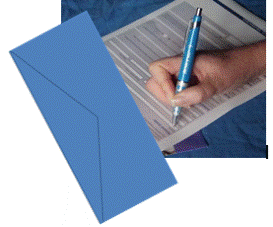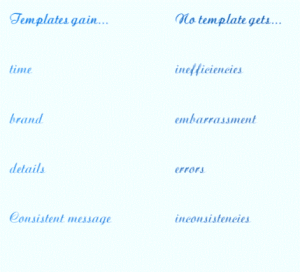I hope you find my writing and business tips and observations useful. My business and blog are dedicated to helping businesses communicate clearly and reach their potential.
Read, subscribe to my newsletter, enjoy!Tash
How businesses can use templates
So I’ve posted about poor template use and given some tips on maximising your use of templates.
But maybe you’re wondering what sorts of templates you could use in the first place. Or whether it is worth the effort to prepare a template.
What are templates for?
Templates are great for
- saving time as you don’t have to start a document from scratch each time you use it. This applies to commonly used documents (so you save time regularly) and infrequently used documents (so you don’t have to search for the ‘last time you did something like this’ to find the details).
- ensuring consistency over time and between staff members. A template means everyone says the same thing so there is no confusion.
- building your brand through consistency in style as well as consistency in the actual message. Imagine one staff member writes formal letters while another writes casual letters in the same circumstances – a template means both use the same style.
- ensuring all important details are included. In the rush of everyday, it is easy to write something and forget a particular detail; a carefully prepared template will have those details (either in full or as a field for you to enter the correct information)
So, what templates can we use?
Ok, that’s as easy as answering ‘what letters can we use in our business?’
There are many different things that can be put into a template for improved efficiency and branding. So this list is a sample to get you thinking of what can be changed in your business.
- one-off use of major business document templates like a style guide, marketing plan, business plan and personnel manuals. (Note by one-off I mean the template is generally used once but the document itself is updated periodically).
- regularly used documents such as sales letters, enquiry letters/emails, welcome letters, overdue accounts notices
- briefs for suppliers such as writers, designers, programmers
- an outline template for items such as blog posts, management reports and media releases
- general stationery can be set up as templates – for example, a letterhead can have the date/name/address/greeting fields prepared and a prepared minutes format can make reporting on meetings much easier
- technical and/or legal documents such as terms and conditions for competitions, customer contracts and instruction manuals/guides.
What other templates have you used that have made your business life a bit simpler and easier?
Consistency over stats
![]() In baseball, my theory is to strive for consistency, not to worry about the numbers. If you dwell on statistics you get shortsighted, if you aim for consistency, the numbers will be there at the end.” – Tom Seaver
In baseball, my theory is to strive for consistency, not to worry about the numbers. If you dwell on statistics you get shortsighted, if you aim for consistency, the numbers will be there at the end.” – Tom Seaver
I rediscovered this quote from my August 2009 newsletter, along with my article on consistency, and thought it worth highlighting again.
What is consistency?
Before discussing what consistency means within a business, here is the definition:
consistency: applying to the same principles or guidelines, not contradicting
In simpler terms, consistency means made up of the same things. So being consistent in a restaurant means always using the same ingredients for a dish – swapping fish into a beef curry gives a different result and is not consistent.
How would a restaurant survive if some dishes are made with care while others are put together quickly? The lack of consistency would confuse diners – and those getting a poor dish the first time may never return.
For business communications, consistency means making all the words, images, layouts and messages work together with the same look and feel, the same overall style. If everything is consistent, the background message remains the same regardless of the specifics of each piece of writing.
Consistency over stats
It’s easy to get distracted and try something new in the hope of fast results.
For example, some people get caught up in the number of visitors coming to their blog and hear that more posts means more traffic.
So they write two posts a day instead of three a week but time is limited so many posts are written fast with less care. Traffic may rise initially with the more frequent posts, but people won’t come back as often if they can’t rely on the quality of posts.
It may be slower, but three consistently good posts will attract more loyal readers than one good and nine poor posts a week.
Have you ever worried over the numbers at the sake of quality and consistency?
Maybe you have been a customer of a business that got distracted from consistency – how did that affect your relationship with the business?
Are templates cheating?
Sometimes people talk about templates as if they are cheating, inferior and inappropriate as a business tool.
I don’t agree – there are times a template is not the right answer but they can be very useful in business.
Using a template doesn’t mean everything is exactly the same – adjustments are made to suit the purpose.
Templates for letters, emails, style guides, procedures, web pages and other business materials can help your business in three key ways.
- Consistency
If every letter sent from your business has the same format, it looks professional, builds your brand and shows attention to detail - Time saving
Using a template saves a lot of time. An email or webpage template can reduce the time needed for formatting, setting meta data and remembering the necessary details (phone, ABN, disclaimer, etc), and so on. - Getting started
A template can provide a starting point and can be much easier to work from than a blank page – this saves mental energy and time. If you don’t know where to start with preparing a style for your business, a corporate style guide template can get you started and inspire you to ask the right questions
I think templates are suitable for many things (e.g. procedures and standard information) although they can be misused and abused.
What templates do you use (or have you used) in your business? What advantages do you get from them?
Consistency includes contacts
Consistency is an important aspect of building your brand. It is easy to remember to always use the same colours, fonts and logos, but you also need consistency in the details you provide.
For instance, I recently received an email where the sender’s email address was different to the one in the signature (and I mean completely different – names and domains varied!) and both were different to the URL of the business! I didn’t try any of them and deleted the email…
Contact details are not only important for branding and consistency, they are also crucial in building trust. A business that uses a different email address to what they advertise or refuses to give any contact details on a website and so on can give the impression of hiding something – not a great way to establish trust.
Personally, I also notice when people use an email address that doesn’t match their URL. For one thing, why lose the promotional advantage of using your own domain name? And why promote someone else’s business instead? Using a different domain to your own also looks unprofessional – especially if it is a hotmail address.
What do you think of a business that doesn’t have contact details consistent with your domain? Does it impact on your sense of trust?
Branding the little things
Building a brand is an important way to develop your business and attract customers, but I read a blog post recently that reminded me of branding even the small things to match your style guide.
Kylie posted that customising and branding your invoices is useful, and quite easy. Personally, I have always had my logo and other details in my invoices, but I hadn’t thought about changing the font. Many people would say that invoices are boring and nuisances rather than marketing tools – and that no one would ever notice what font the dollars are printed in – but it still part of being consistent and reinforcing the look of your business. It also shows an attention to detail for anyone who does notice the details of your invoice.
So, is your invoice branded? Does that include choice of font, wording style and colours/backgrounds?
Font sizes…
Surfing some of my favourite blogs today, I came across a post by Donna-Marie about choosing suitable fonts. As well as being a good summary of which fonts work well in different media, it reminded me of someone recently asking about using different sized fonts – and recent experiences of unsuitable font choices.
I remember doing school assignments where I’d use different fancy fonts for each heading and changed the text to suit the amount of information in each section, and so on – and I was proud of being so versatile! But looking back (or at children’s work now) I can see that it looks childish and puts the focus on the fonts rather than the content. It isn’t very professional to give the impression you are trying to minimise the content!
As a general rule, it is better to stick to one font style and size in a single document. It is consistent which makes it easier to read (the eye doesn’t have to keep adjusting to different fonts) and it also looks clean and professional. And to be honest, it is also easier to prepare than swapping fonts all the time!
The common exceptions in font sizes would be:
- heading and sub-headings are often a little larger than the text font
- labels on diagrams and tables are often smaller to work with the labelled items
- the ‘fine print’ such as a disclaimer, a copyright notice or unsubscribe information – this text can be smaller but it must still be big enough to easily read so less than 8 point is getting too small in most cases. I recently edited a document which had footnotes to a table in a 7 font and it was too small to read and also looked out of place amongst the 11 font table and general text.
- fonts within an ad design may show more variation, but be careful to not overdo it
If you are tempted to change font sizes to break up a chunk of text, consider bullet points, italics, bold, more paragraph breaks and page layout as alternatives.
Running effective surveys
 Aside from the content of the survey itself, it is very important that any surveys or feedback forms are well prepared in other ways.
Aside from the content of the survey itself, it is very important that any surveys or feedback forms are well prepared in other ways.
I just answered a survey that included at least three of the following mistakes and it has left with me with the impression that those business owners don’t care about details or consistency – so why would I trust them with promoting my business (their apparent service)?
So before you make a survey available to your customers, check how it presents and do a test run to see it really does work – better yet, get someone else to do the test run for you.
- Be careful of what you make a compulsory questions/answer. If a compulsory response isn’t included, the person can’t submit their survey and may get frustrated and move on which means you don’t get their feedback. And most people won’t tell you they had this problem, either.
So if you do make a question compulsory to answer, ensure there is an answer for everyone so all can answer – even if one answer is “don’t know”, “prefer not to answer”, “none of the above” or similar.
And if you give a range of answers including ‘other’, make sure that ‘other’ is an acceptable answer. I have done surveys where I can’t submit unless I choose a response instead of ‘other’ – forcing me to choose an inaccurate answer as well as my true comments. - Most small (and even larger) businesses use a third party to run surveys. This generally means the survey appears more professional and can be easier to use – for example, not many businesses can afford the programming to do an online survey each time. While this is a valid practice, minimise the third party as much as possible.
For example, if you complete this business branding survey, which is run on a third party survey site, you will be directed to the host business’s website once you click on ‘submit’. This way, the business itself is being promoted and gains more traffic from people doing the survey. The other option is to let people go to the third party’s homepage once the survey is complete. - Brand the survey as much as possible. If the survey is a serious part of your business, it should continue your brand. That means add a logo, use your corporate colours, use the same style of writing, use your corporate fonts and use relevant images as applicable. You may not be able to make it match your web template or change fonts, for instance, but brand it as much as possible.
- Keep it as short as possible – you probably want responses from a range of people, not just the bored and those who love surveys, and busy people don’t have time for long surveys unless they see a potential benefit from it.
Be careful with the number of questions – if one more question or comment will create a new page, review it. Someone scanning a survey will see there is another page and decide it is too long which would be a pity if the next page was only one question – or worse, if the next page is simply a “thanks for doing our survey” message. - Look at the presentation – is there too much text so it looks complicated or time consuming? Does it look professional or just thrown together? Is there a nice mix of multiple choice answers and written responses, or just written responses? Does it look easy to complete?
Once you are confident you have good questions and a well prepared survey/questionnaire, the next step is to announce and promote it appropriately. Remember that many people won’t fill in the survey just because you want them to – you have to give them a reason to want to do it themselves.
And then make sure you make use of your survey results!
Use your words wisely!
Keeping to the course
I did a bit more driving than usual over November and I noticed a few idiots on the road. You know the type – overtake every car they can, speeding well above the limits, but somehow staying in sight and stopping at the same red lights as you.
Honestly, it is costing them in stress and petrol use, and greatly increases their risks (of accidents and fines).
Yet travelling safely & steadily gets you where you’re going with less risk, less cost and you arrive ready for whatever awaits.
Thinking about these drivers, it occurred to me that driving is like running a business. Some people start a business and run at it, trying to make a fortune in the first six months, changing direction as each new opportunity or distraction arises. These people are often stressed and overworked.
Others take their time – do some research, study up on various topics, gather advice and opinions, set up systems, and so on – and develop strong foundations for their business. These people may sometimes be frustrated at things not going fast, but they stay the course and develop a good business.
Consistency, steady progress, solid foundations, patience, planning deliberate moves – all of these traits will make business growth a little slower but a lot stronger.
So how do you run your business? And how do you approach a major writing project?
Style Sheets
Business writing, well good business writing, is made up of a lot of elements. One important element that isn’t mentioned very often is consistency.
While consistency in style, design and so forth are important, I am talking about consistency within the content itself.
It can be consistency in spelling (advisor or adviser?), capitalisation (Internet or internet?), hyphenation (multi-media or multimedia?), abbreviations (A.T.O. or ATO?) or apostrophes (CDs or CD’s?) Sometimes there is a right or wrong way, but in other cases either way is acceptable. However, switching between them in the same document or on your website can be distracting and even annoying. It also doesn’t send a good message about your attention to detail.
Let’s take the example of adviser and advisor. Both are acceptable spellings of the word, although some dictionaries list advisor as the American spelling; adviser tends to be more common in Australia.
If you are writing a webpage about your services as a business adviser, it is likely you would write adviser quite a few times. And by the time you have written the entire website, you will probably have used adviser at least a dozen or so times.
Now, if you have a strong preference for writing adviser, it will be easy and you probably wrote adviser every time. Likewise if you prefer advisor.
But what if you can never remember which is the ‘right’ way? Or you prefer adviser but whoever wrote the older webpages used advisor and it’s hard to remember which to use.
How can you remember which way to spell adviser? And at the same time remember to keep everything else consistent?
One way is to prepare yourself a style sheet.
How does a style sheet work?
Your style sheet can simply be a list of things to watch out for, or it can be a grid with each square being a letter of the alphabet so you can sort the things to watch out for.
An example style sheet is:
Style Sheet for Word Constructions Blog
Adviser
CDs
database
e.g.
internet
multimedia
program
Next time I need to write about a multimedia program within my blog, I just check that style sheet for the appropriate spelling.
Style sheets can be particularly useful if you have more than one entity to write about. You might have a style sheet for your job and another one for your own business, or maybe you need a style sheet for each client.
Company and product names can also be included in a style sheet as getting these names correct is an important part of branding.
The time it takes to create a style sheet will be paid for by having greater consistency in your writing. And a style sheet makes a great starting point for a style guide later on.




Recent Comments